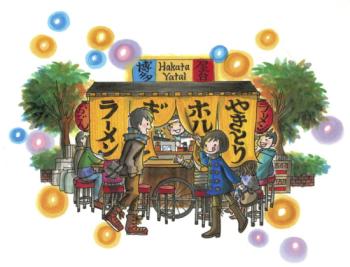Hakata Culture vol.61
Stalls Brighten Fukuoka Nights

Stalls are an indispensable part of the Fukuoka night scene. They appear throughout the town as dusk nears, and their operators begin preparing the oden, ramen, and other foods for the popular palate at affordable prices. About 150 stalls now operate in Fukuoka, the largest number of any city in Japan. The scene of their noren fluttering in the night breeze, down neon-lit streets of office buildings, has become an image typifying the city.
Dating from the Edo period, the stalls were originally counters with roofs outside restaurants that sold food to passersby. The merchants soon realized the advantages of moving to locations with more pedestrian traffic, and so attached wheels to their stalls and took them to busier streets. Their initial offerings were the Japanese equivalent of fast food, such as nigirizushi, soba and tempura.
There was a sharp increase in the number of stalls after the Second World War, when people lacked the resources to establish shops of their own during the postwar turmoil. While these stalls gradually disappeared in other parts of the country, they thrived in Fukuoka, and their operators even formed a business association. Though many stalls remain today, they face several challenges including a system that prevents the transfer of ownership, which means the business is limited to a single generation. Thus, the number of stalls in operation dwindles year by year.
Nevertheless, the stalls are part of the daily life of the people, and have now become a tourism resource. Debate has begun in Fukuoka City over how to resolve the various problems related to their operation. Last year, the city government appointed a person to head a municipal department for dealing with these problems, the first time such a measure has been taken in Japan. We hope their solutions meet the approval of the operators, the customers, and their neighbors on the city streets.
福岡の夜をにぎやかに彩る屋台
福岡の夜に欠かせないものといえば屋台。夕方になると街のあちこちに出現し、おでんやラーメンなど庶民的な料理が手ごろな料金で味わえます。現在、福岡には約150軒の屋台が営業していますが、これは日本でいちばん多い数。ネオン輝くビル街に屋台の暖簾が揺れる風景は、福岡の代名詞ともいえるのではないでしょうか。
江戸時代に誕生した屋台は、もともと料理屋の店先に屋根付きの台を置き、通行人に料理を売ったのが始まり。どうせなら人通りの多い場所へ売りに行ったほうがいいと、この台に車をつけて、大通りまで引いて行ったのが現在の屋台の形です。当初は、にぎり寿司、ソバ、天ぷらなど、すぐに食べられる料理を提供していて、今でいうファーストフードのような存在でした。
福岡の屋台は第2次世界大戦後に一気に増えました。戦後の混乱の中、店を構える余裕のない人が多かったからです。その後、全国各地では屋台は次第に姿を消していきましたが、福岡では屋台組合が結成されるなどして現在も多くが残っています。ただし課題も多く、また、屋台の名義変更や譲渡ができず、営業は一代限りという規制があるため、年々屋台の数は減り続けています。
福岡の人々の暮らしに溶け込み、今では観光資源でもある屋台。さまざまな課題を解決しようと、福岡市では屋台について議論を始めています。昨年は屋台の課題解決を業務とする「屋台課長」が全国で初めて誕生しました。屋台の持ち主はもちろん、利用する人も、近隣の人も、納得できる解決策が見つかるといいですね。

